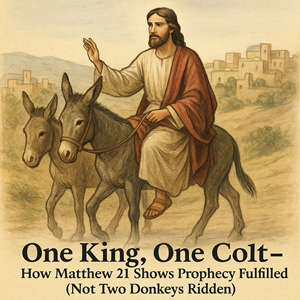
One King, One Colt
How Matthew 21 Shows Prophecy Fulfilled
(Not Two Donkeys Ridden)
Introduction
Matthew 21:1-7 tells of Jesus' triumphal entry into Jerusalem. Some readers puzzle over the text: did Jesus really ride two donkeys? A careful look at the Gospel accounts and their purpose shows that He rode only one animal - the young colt - while its mother simply walked alongside.
What Matthew Actually Says
Matthew records Jesus' instruction:
Go into the village over against you, and straightway ye shall find an ass tied, and a colt with her: loose them, and bring them unto me. - Matthew 21:2
And the disciples:
...brought the ass, and the colt, and put on them their clothes, and they set him thereon. - Matthew 21:7
Two animals are mentioned because both were brought. The garments (blankets) were laid across both animals to make either available. The Greek construction of set him thereon naturally refers back to the garments, not to both animals as mounts.
Harmonizing the Gospels
Mark 11:7, Luke 19:35, and John 12:14-15 each mention only the colt. Together they present a single, unified picture: Jesus sat on the young, never-ridden donkey (a symbol of peaceful kingship, see Zechariah 9:9). Matthew alone notes that the mother came along, almost certainly to keep the colt calm as it had never yet been ridden. (See Mark 11:2, Luke 19:30)
Why Matthew Mentions Both Animals
Matthew's Gospel is especially intent on showing Jesus as the Messiah who fulfills Old Testament prophecy. He repeatedly writes, that it might be fulfilled which was spoken by the prophet... (See Matthew 1:22; 2:15; 4:14; 8:17). Here he cites Zechariah 9:9:
Tell ye the daughter of Sion, Behold, thy King cometh unto thee, meek, and sitting upon an ass, and a colt the foal of an ass.
In Hebrew poetic parallelism, ass and colt describe the same animal in two ways, not two separate mounts. By mentioning both animals present, Matthew underscores that the prophecy's full wording is perfectly met.
Matthew's Distinctive Emphasis
Matthew - Written with a Jewish audience in view; highlights Jesus as the promised King and fulfillment of the Law and Prophets.
Luke - Shows Jesus as Savior for all people, stressing mercy and inclusion.
John - Declares Jesus' eternal divine nature, focusing on belief in Him as the Son of God.
Matthew's attention to prophecy and detail explains his double mention of the animals.
Summary
Jesus rode only one donkey - the colt - in His triumphal entry. The mother donkey's presence helped the young colt remain calm and allowed Matthew to demonstrate the precise fulfillment of Zechariah's prophecy. Far from a contradiction, Matthew 21 enriches the scene: the Messiah-King enters Jerusalem meek and deliberate, fulfilling Scripture word for word and showing Himself the long-awaited Son of David and Savior of the world.